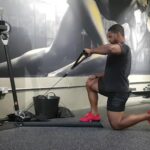External Rotation of Shoulder: Unlocking Strength and Flexibility
Introduction
The shoulder, a marvel of joint design, allows for a wide range of motions crucial in our daily lives. Among these, external rotation holds a pivotal role, enabling activities from reaching overhead to throwing a ball with precision. In this article, we’ll delve into the intricacies of external rotation, exploring its significance, common issues, and effective ways to enhance and protect this vital shoulder movement.
Understanding External Rotation
External rotation refers to the outward movement of the shoulder joint. It involves the coordinated effort of several muscles, including the infraspinatus and teres minor. This movement is essential for functional shoulder mobility and stability.
Significance in Daily Activities
From waving hello to lifting groceries, external rotation plays a part in various routine activities. It significantly contributes to the shoulder’s overall range of motion, allowing for fluid and pain-free movements.
Common Issues and Causes
Despite its importance, external rotation can be compromised by various factors. Rotator cuff injuries, poor posture, and overuse are common culprits that can lead to restricted external rotation and discomfort.
Diagnosing External Rotation Problems
Recognizing the signs of external rotation issues is crucial for timely intervention. Symptoms such as pain during specific movements or stiffness can indicate underlying problems. Seeking professional medical advice and undergoing relevant examinations are essential for an accurate diagnosis.
Physical Therapy and Rehabilitation
Addressing external rotation problems often involves targeted physical therapy. Engaging in prescribed exercises, under the guidance of a professional, can gradually restore and improve external rotation.
Preventing External Rotation Injuries
Prevention is key to maintaining shoulder health. Incorporating proper warm-up techniques, paying attention to ergonomic factors, and being mindful of overuse can significantly reduce the risk of external rotation injuries.
Strengthening Exercises
Specific exercises designed to strengthen the muscles involved in external rotation are integral to rehabilitation. These exercises may include resistance training and focused movements to enhance shoulder stability.
Nutrition for Shoulder Health
Nutrition plays a role in the overall health of muscles and tendons. Ensuring an adequate intake of nutrients such as protein, vitamins, and minerals supports optimal shoulder function.
Home Remedies for External Rotation Improvement
In addition to professional guidance, simple home remedies like adequate rest, ice application, and gentle stretches can aid in the improvement of external rotation.
Alternative Therapies
Exploring alternative therapies such as massage and acupuncture can provide complementary benefits to traditional treatments. These methods focus on relieving muscle tension and promoting overall shoulder health.
Case Studies
Real-life examples highlight the potential for improvement in external rotation through dedicated efforts and the right interventions. These case studies offer insights into the journey of individuals who successfully enhanced their shoulder mobility.
Tips for Athletes and Fitness Enthusiasts
For athletes and fitness enthusiasts, tailoring workouts to their specific sport while balancing strength and flexibility is essential. Customizing training routines can optimize performance and prevent injuries.
Future Trends in Shoulder Health
As technology advances, so do treatments for shoulder-related issues. Keeping an eye on emerging trends and incorporating innovative therapies can contribute to better shoulder health outcomes.
Conclusion
In conclusion, external rotation is a fundamental aspect of shoulder function that should not be overlooked. Whether recovering from an injury or proactively working to maintain shoulder health, understanding the significance of external rotation is key. By incorporating a combination of proper nutrition, targeted exercises, and preventive measures, individuals can unlock the full potential of their shoulder mobility.
FAQs
- How can I tell if I have issues with external rotation?
- Look out for signs such as pain during specific movements, stiffness, or a limited range of motion.
- Are there specific exercises to improve external rotation?
- Yes, physical therapy often includes targeted exercises to strengthen the muscles involved in external rotation.
- Can poor posture affect external rotation?
- Yes, poor posture can contribute to shoulder issues, including restricted external rotation.
- Is massage beneficial for improving shoulder mobility?
- Massage can help relieve muscle tension and promote overall shoulder health.
- Where can I learn more about emerging trends in shoulder health?
- Stay informed through reputable health sources and consult with healthcare professionals for the latest advancements.



